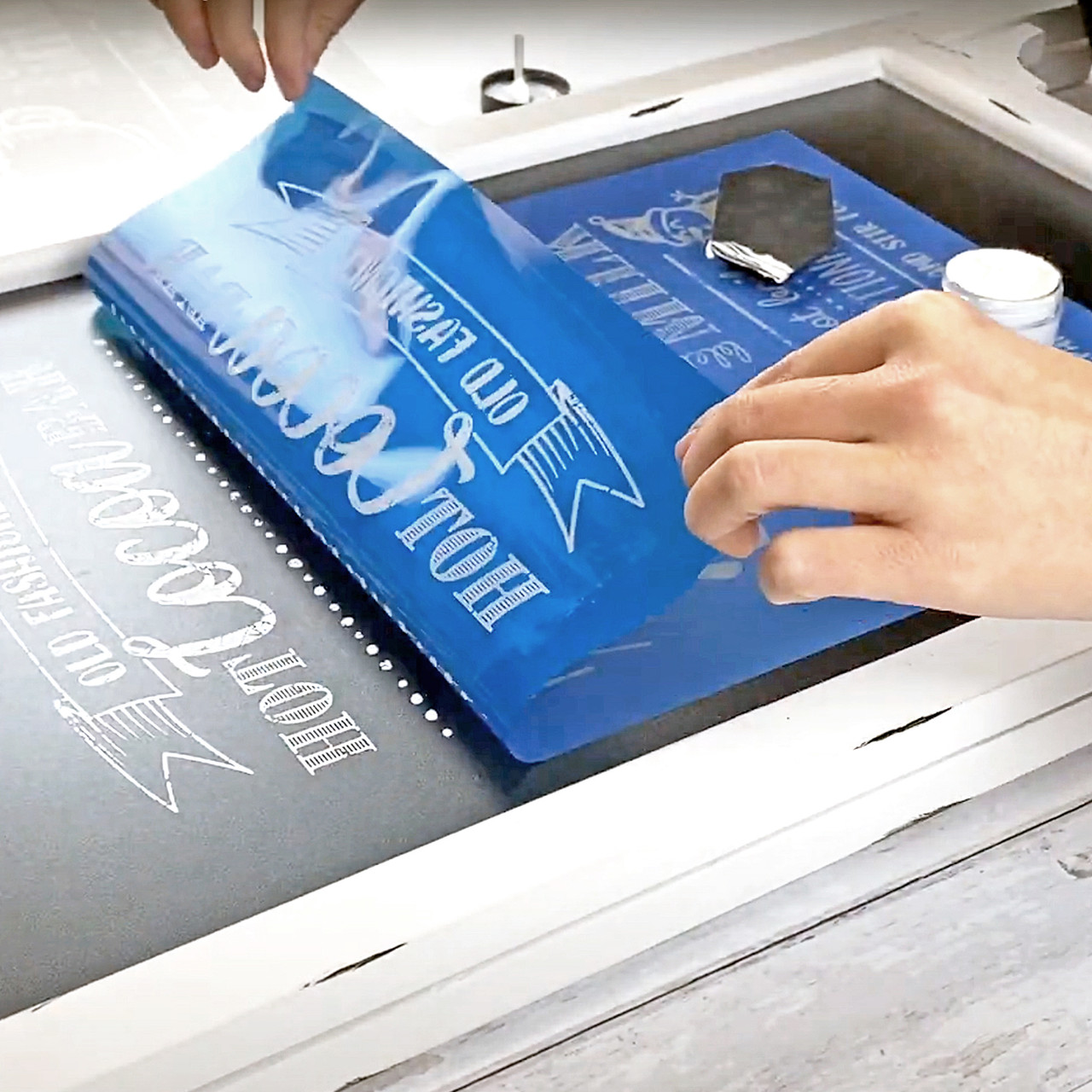High-End Silk Screen Printing for Premium Garments
Wiki Article
Display Printing Uncovered: Every Little Thing You Need to Learn About Tee Shirt and Garment Printing Techniques
Display printing is a remarkable technique that combines art with strategy, offering endless possibilities for creativity. Ready to discover the vital aspects that make display publishing an art type?
The Basics of Screen Printing: Exactly How It Works
When you plunge into display printing, you'll find it's both an art and a scientific research. At its core, screen printing entails developing a pattern, or display, that enables ink to pass via only in details areas.Setting the screen over the textile, after that utilize a squeegee to push ink with the display onto the garment. Each step is crucial, and grasping them will certainly elevate your screen printing skills, changing simple garments right into special, meaningful pieces.
Sorts Of Screen Printing Techniques
Once you understand the essentials of display printing, it's time to discover the numerous strategies that can elevate your layouts. One popular technique is standard display printing, where ink is pressed with a stenciled display.If you're going for great details, think about discharge printing. This strategy gets rid of color from the material, leaving a soft, vintage look. Another option is plastisol printing, understood for its resilience and vibrant colors, making it a preferred for several brand names. Experiment with halftone printing to develop slope effects and intricate layouts. Each method has its distinct charm, so do not be reluctant to attempt them out to locate what fits your style best!
Important Tools for Screen Printing
To achieve magnificent results in display printing, having the best tools is fundamental. Initially, you'll need a strong screen printing framework, which holds the mesh that moves your design onto the garment. Next off, invest in high-quality mops; these are important for using ink equally across the screen. You'll additionally call for a good exposure device to create your screens, in addition to a washout cubicle for cleaning them after use. A dependable warm resource, like a conveyor dryer or warm press, is essential for treating your prints to guarantee durability. Do not neglect a proper office, equipped with tables and storage for your materials. Lastly, safety equipment, such as masks and gloves, will keep you risk-free from chemicals and inks. With the right tools, you'll be well on your means to creating professional-quality prints.Picking the Right Inks and Materials
When choosing inks and products for display printing, you require to consider the kind of ink that functions best for your project. Consider material compatibility to assure your designs look last and wonderful long. Explore environment-friendly ink alternatives to make your printing process much more sustainable.Sorts Of Display Inks
Choosing the ideal screen ink is important for achieving vibrant, sturdy prints that satisfy your task's demands. There are several types of display inks to analyze. Specialized inks, such as glow-in-the-dark or metallic, can include one-of-a-kind results to your designs.
Textile Compatibility Factors To Consider
Recognizing textile compatibility is essential for achieving top quality screen prints, specifically considering that various products react uniquely to various inks. Always check your inks on sample textile to guarantee they stick appropriately and maintain shade integrity. Furthermore, keep in mind that material weight and texture can impact the final result, so selecting the ideal ink and material combination is crucial for your job's success.Eco-Friendly Ink Options
Environmentally friendly inks are ending up being a preferred choice for screen printers who want to decrease their environmental impact while preserving top quality. When selecting inks, think about water-based inks, which are much less damaging and simpler to clean up contrasted to standard solvents.In addition, search for inks made from sustainable sources, such as soy or vegetable-based choices. By picking the appropriate inks and products, you'll not only create sensational designs however likewise add to an extra lasting printing procedure. Make the switch, and your prints will certainly reflect your dedication to the atmosphere!
Preparing Your Style for Display Printing

File Layout Demands
To ensure your style looks lively and sharp on textile, you'll require to pay very close attention to submit style requirements for display printing. Begin with vector files like AI or EPS, as they can be scaled without shedding quality. If you utilize raster images, choose for high-resolution documents, such as TIFF or PNG, ideally at 300 DPI. Prevent making use of JPEGs, as they can lose clearness when resized. Additionally, see to it your layout has a transparent background to prevent undesirable white sides on your prints. Lastly, maintain color modes in mind; CMYK is typical for screen printing, so transform your RGB develops as necessary. By following these guidelines, you'll set your art work up for an effective print.Color Splitting Up Strategies
Color splitting up is a necessary step in preparing your layout for screen printing, and grasping it can substantially enhance your print quality. You'll need to break your style right into specific shades, as each shade calls for a separate display throughout printing. Beginning by recognizing all the colors in your design and develop layers each. You can utilize software application like Adobe Photoshop or Illustrator to isolate and different shades successfully. Be specific to save each layer as a different data, typically in a format like TIFF or PSD. This accuracy not just assures precise shade depiction however likewise improves the printing process. By paying attention to shade splitting up, you'll accomplish professional and vibrant outcomes in your screen-printed garments.Resolution and Dimension
Accomplishing the most effective outcomes in display printing starts with guaranteeing your design has the right resolution and dimension. Preferably, your artwork must go to the very least 300 DPI (dots per inch) for sharp, clear prints. If you use lower resolution, your end product could look unprofessional and why not try these out pixelated.When it involves size, think about the measurements of your print area. Style your art work to match the final print size, preferably developing it in the actual dimensions you'll be publishing. By doing this, you'll avoid any type of unexpected scaling problems.
Constantly examine your design in both vector and click for source raster styles. Vector graphics can be scaled without shedding top quality, making them optimal for display printing. Preparing appropriately will guarantee your style looks remarkable on every garment!
Step-by-Step Display Printing Process
Display printing is a dynamic process that permits you to develop dynamic styles on numerous surface areas. To get started, you'll need a display, solution, and your picked ink.After washing out the unexposed emulsion, your screen is prepared. Establish it up on your printing surface and align your garment underneath it. Pour ink onto the screen and make use of a squeegee to press the ink via the pattern onto the material. Lift the display thoroughly and allow the print completely dry. Lastly, treat the ink using heat to guarantee sturdiness. That's it! You've successfully display printed your layout.
Tips for Effective Display Printing Projects
While you're diving into your display printing jobs, bear in mind that preparation is key to success. Start by collecting all your materials-- inks, screens, garments, and mops. A tidy work area helps prevent undesirable errors, so clean up before you start.Following, verify your art work is high-resolution and appropriately sized for your garment. Test your display for appropriate exposure and clean it extensively to prevent spots. When mixing your inks, comply with the manufacturer's guidelines to attain the right uniformity.
Throughout printing, apply also stress with your squeegee for consistent results. Do not hurry; take your time to confirm each print fulfills your requirements. After printing, let your garments dry entirely before managing or packaging them.
Lastly, always maintain an example of your help future reference. By doing this, you can analyze your progress and enhance your methods with time. Pleased printing!

Often Asked Concerns
How much time Does It Require To Establish a Display Printing Task?
Establishing a screen printing job normally takes around thirty minutes to an hour. You'll prepare the screens, mix inks, and adjust the press. The time differs based on complexity and experience, so stay organized!Can I Print on Different Fabric Enters Utilizing the Same Method?
Yes, you can publish on various material types using the same strategy, however you'll need to change your settings and inks. Some fabrics absorb ink in different ways, so trying out assurances the very best results for each material.What Are Common Errors to Avoid in Screen Printing?
When screen printing, stay clear of usual blunders like making use of the incorrect ink, overlooking appropriate exposure times, or avoiding pre-press checks. Always test your setup and keep tidy displays to guarantee quality outcomes each time.Just How Can I Appropriately Clean and Keep My Screen Printing Equipment?
To effectively clean and maintain your display printing tools, you ought to frequently clean screens with proper solvents, check squeegees for wear, and ensure all devices are kept dry and dust-free. Uniformity avoids pricey repair work and boosts efficiency.Is Screen Printing Eco Friendly Compared to Various Other Methods?
Display printing can be more eco-friendly than various other methods, particularly if you use eco-conscious materials and water-based inks. By picking sustainable products and practices, you decrease waste and decrease your influence on the planet.Display Printing Uncovered: Whatever You Required to Know About Tee Shirt and Garment Printing Techniques
At its core, screen printing involves producing a pattern, or screen, that permits ink to pass via only in details locations. Position the display over the textile, then make use of a squeegee to press ink via the display onto the garment. One prominent approach is typical screen printing, where ink is pushed through a stenciled screen.When selecting inks and materials for display printing, you require to take into account the kind of ink that functions finest for your job.
Report this wiki page